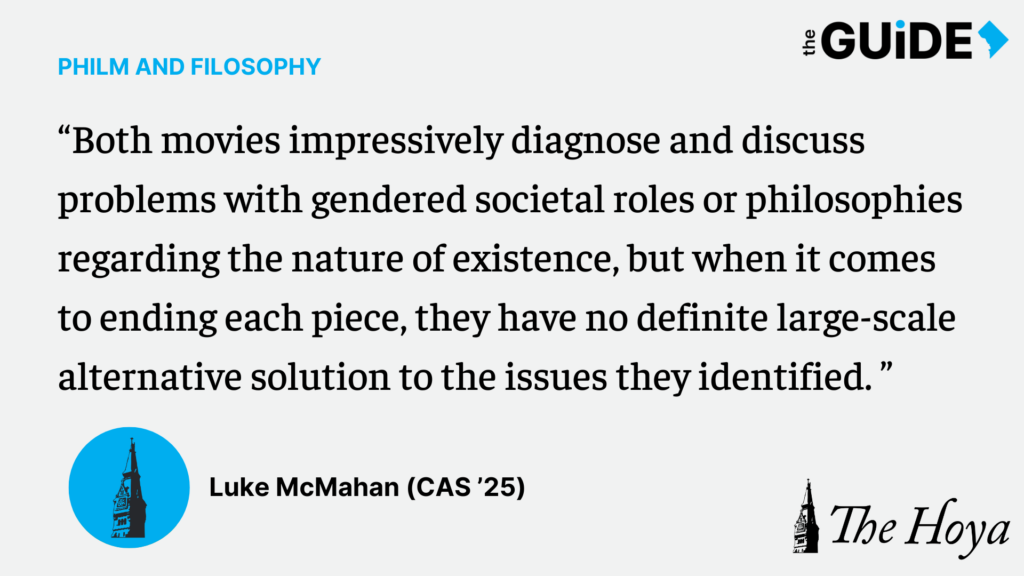This article contains minor spoilers for “Barbie” and “Everything Everywhere All at Once.”
Following the monumental critical and commercial successes of “Barbie” and “Everything Everywhere All at Once” (EEAAO), one may enter their titles into the annals of cinematic history as two of the best movies the 2020s had to offer.
Both films combined fascinating, original concepts with intelligent social and philosophical commentary. Hopefully, they signal a wave of similarly unique and enlightening films in the near future.
But despite their successes, both exhibit an unfortunate characteristic common to such postmodern art objects: an unearned, inconsistent ending.
The bulk of both “Barbie” and “EEAAO” deserve all the praise they have received. “Barbie” examines and critiques present-day gender roles under the modern patriarchal system within a separate world populated with Barbie and Ken dolls. “EEAAO” examines nihilism and existentialism within an action-packed, multidimensional plot.
Both use humor, satire and genre conventions to create imaginative storylines in which the layered and interesting critiques they offer are available to a wide audience, impressively without losing their analytic bite.
But near the end, both films dramatically change their thematic scopes. “Barbie” leaves the realm of patriarchal criticisms and becomes a story about being human, serving up plenty of platitudes about how simultaneously difficult and wondrous life can be. “EEAAO” emerges from two hours of philosophical pondering and becomes a story about family and intergenerational conflict.
Although there is a drop in quality, both endings are relatively well-executed. But quality is not the specific problem.
Firstly, neither film earned their respective endings. “Barbie” was not about the rises and falls of human life, and “EEAAO” did not centrally examine intergenerational conflict in an Asian American family. “Barbie” and “EEAAO” discuss humanity and family conflicts respectively, but neither is the main nor nearly the most well-developed aspect of each film.
Furthermore, the bland bromide-laden conclusions weakened the well-formed critiques and analyses earlier in the films, and they compromise the effectiveness of each film as a whole.
As Robert McKee said in the 2002 film “Adaptation”: “The last act makes a film.” And with the incongruous and comparably weak endings of each movie, “Barbie” and “EEAAO’s” overall messages and legacies are diminished.
But why does this shift occur? And what does it have to do with postmodern philosophy?
First, I must note that “postmodernism” is an overused and inherently undefinable term. But for my purposes, I am using the term to refer to a class of philosophy beginning around the 1960s that is united by a general rejection of metanarratives, or large-scale ideas and accounts used to explain history, human experience or knowledge. Its main mode of critique is deconstruction, in which one weakens a general argument by exposing little inconsistencies and cracks in its makeup, thereby rendering the overall argument useless.
A very common critique of postmodernism is that it very aptly identifies the problems of what it aims to analyze, but it provides nothing substantial to replace them with afterward. Because postmodernists do not believe in metanarratives, they can’t replace the big idea they just dismantled with another big idea.
While I don’t think Greta Gerwig (“Barbie’s” director) or Daniel Kwan and Daniel Scheinert (the directors of “EEAAO”) are postmodernists, I believe their films provide postmodern-like analyses and fall victim to the critiques of many postmodern theories.
Both movies impressively diagnose and discuss problems with gendered societal roles or philosophies regarding the nature of existence, but when it comes to ending each piece, they have no definite large-scale alternative solution to the issues they identified. So instead, since Gerwig and the Daniels wanted to end their films somewhat definitively, both “Barbie” and “EEAAO” resort to weaker, vaguer, more saccharine conclusions about humanity or the importance of family, neither of which are supported by the film as a whole.
While the respective denouements maintain some of the films’ emotional through line, they abandon their analytical through line. Ending a piece of criticism with the cinematic equivalent of, “Well anyways, all that really matters is being human or loving one’s family” devalues their previous well-made points. Unable to end their large-scale critiques with large-scale ideas, each deviates from their central subjects, which unfortunately compromises the strength of the works as criticisms.
I hope more films in the near future tackle large questions like “Barbie” and “EEAAO”. But they must be aware of the trouble that postmodern endings bring to the merit of a film’s criticisms.














